
Station Name: FRANSHAM[Source: Glen Kilday]
Fransham Station Gallery 1: Before 1936 - September 1964 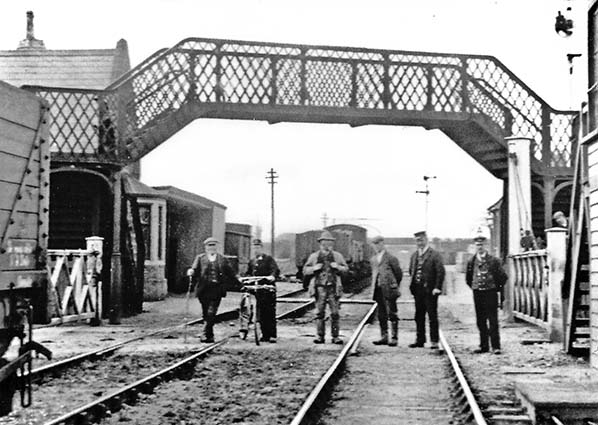 Fransham Station, footbridge and level crossing, the view looking west along the single main running line. The edge of the signal box is just in shot. The date is unknown, certainly before 1936 when the bridge was removed by the LNER. The identities of the people are not known: 2nd left is presumably the postman (there was a post box at the station)and two on the right have railway uniforms. The GER signals in the background share a post for up and down directions. By this date the points at the east end of the loop had been removed so the line on the left is a siding.
Photo from Bob Jenkins collection  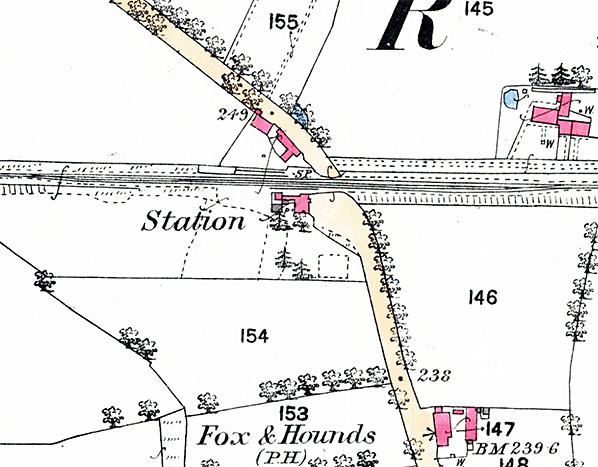 1884 1:2,500 OS map. The station facilities were probably ‘as built’ with a short up platform in front of the station building and a longer down platform opposite the building. At this time there wasn't a waiting room on the down platform. The road is crossed by two lines with that nearest the building shown as a loop accessible from east and west. 1884 1:2,500 OS map. The station facilities were probably ‘as built’ with a short up platform in front of the station building and a longer down platform opposite the building. At this time there wasn't a waiting room on the down platform. The road is crossed by two lines with that nearest the building shown as a loop accessible from east and west.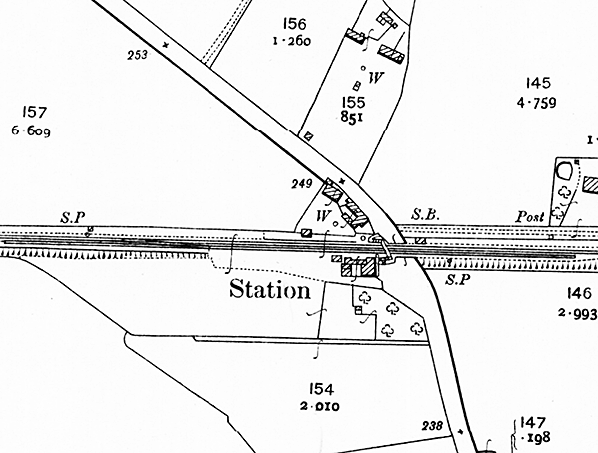
1905 1:2,500 OS map. The former loop has been converted to a siding protected by a headshunt to the west. A pedestrian overbridge was in place directly to the west of the road crossing - a unique feature at smaller stations on the Lynn & Dereham. A signal box had been built to the east of the road.
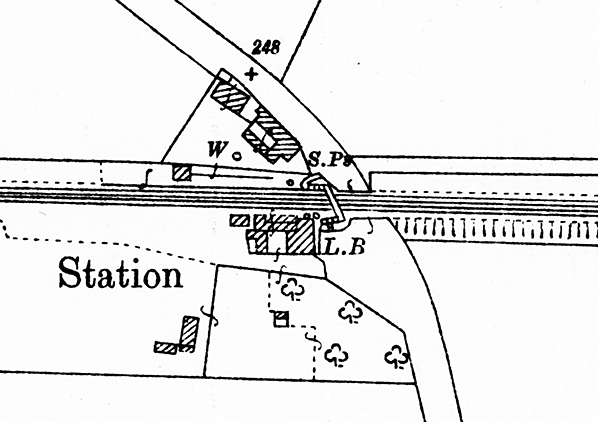 1928 1:2,500 OS map. In mapping terms nothing had changed in the near-quarter century since the Edwardian map apart from the removal of the signal box. A post box (LB) is identified at the station; this is visible in a number of the photos.
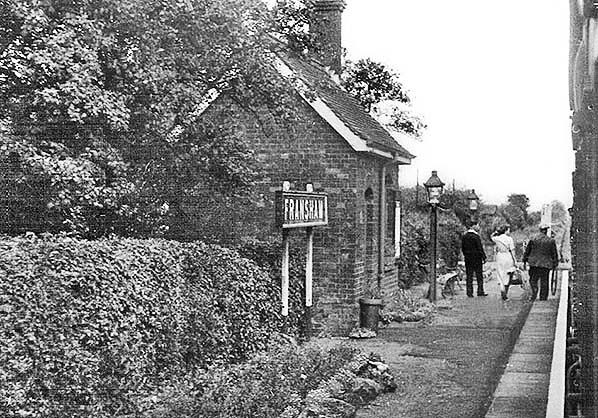
Three passengers have alighted from a westbound (up) train at Fransham in 1955. Oil lamps mounted on posts made from modified rail can be seen. The hedge is clipped and the garden well tended.
Photo from Bob Jenkins collection 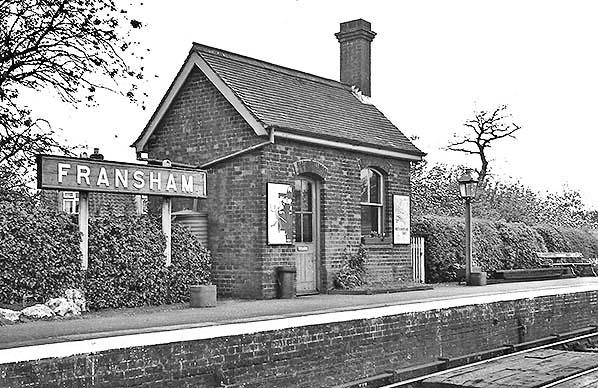
The platform, waiting room and name board at Fransham. The date is the early 1950s - the passenger safety poster is a British Railways product of that era.
Photo from Bob Jenkins collection 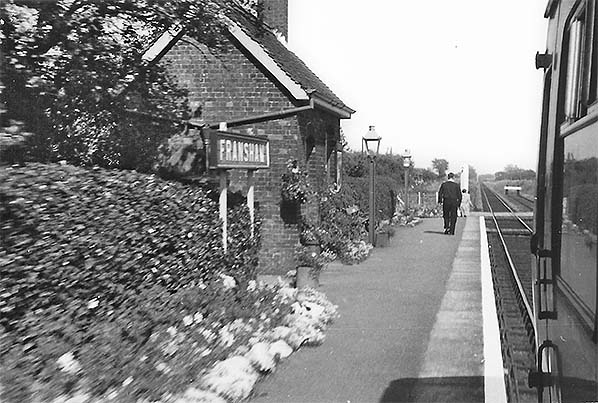
Looking to the east at Fransham Station. The date is after September 1955 when DMUs replaced steam trains on the line. The garden is well tended and the goods line remains in place. The oil burner has gone from the platform lamp when compared with the 1955 image. Note the buffers on the far side of the crossing, there used to be points here from the main line and the siding was a passing loop.
Photo from Bob Jenkins collection 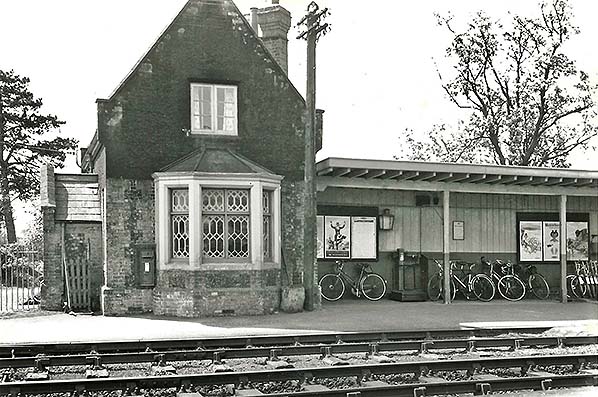 Neat and tidy Fransham Station buildings on 25 May 1962. The running line is in the foreground, the goods siding nearer the building.
Photo from John Watling, Great Eastern Railway Society 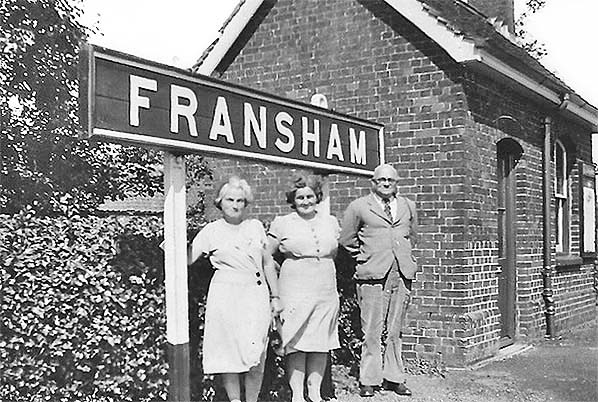
posed picture beside Fransham waiting room, date and subjects unknown.
Photo
from Bob Jenkins collection
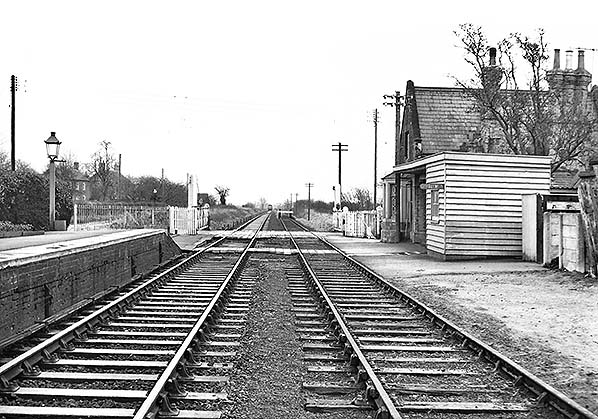 Looking east across the level crossing at Fransham towards a diesel train on the main line. The goods siding on the right appears little used. The date is unknown but before 11 September 1964 by which date the lamp-room, Gentleman’s toilet and canopy had burnt down.
Looking east across the level crossing at Fransham towards a diesel train on the main line. The goods siding on the right appears little used. The date is unknown but before 11 September 1964 by which date the lamp-room, Gentleman’s toilet and canopy had burnt down.Photo from Bob Jenkins collection 7a.jpg)
Looking west from Fransham level crossing in September 1964, shortly before the fire in the lamp room. Note the gauge over the siding on the left, in the distance the points and the head shunt can be made out. The bungalows on the left are Station Drive, a new housing development in the area.
Copyright photo from Stations UK Click here for Fransham Station Gallery 2:
|
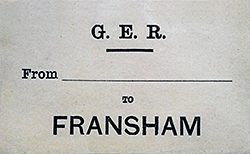 The station was smaller than others on the Lynn & Dereham. At first Fransham had two platforms and a passing loop. A short platform lay directly in front of the station building on the up side. There was a longer platform on the down side. These features are shown on the 1884 OS 25inch map. By the time the 1905 map was surveyed the point leading to the loop at the west end had been removed and its line converted to a siding. At the west end of the loop a headshunt was added. The station building was on the up side and was grand if on a small scale! Its roof-line lay at right-angles to the line. A slate roof covered a building of knapped local flint with beige brick corners. A fine 3-facet bay window with intricate glazing panels and its own slate sub-roof looked out over the line. Entry to the building was through a nicely proportioned porch of beige brick on the east side. On the west side two ornate chimney stacks, one with a single flue the other with three, ended higher than the roof line. On the same side a flat-roofed portico provided some shelter for passengers. At some point a canopy was added but that burnt down in the 1960s as a result of a fire in the adjoining lamp shed. When opened there were two boarded crossings to gain access to the platform.
The station was smaller than others on the Lynn & Dereham. At first Fransham had two platforms and a passing loop. A short platform lay directly in front of the station building on the up side. There was a longer platform on the down side. These features are shown on the 1884 OS 25inch map. By the time the 1905 map was surveyed the point leading to the loop at the west end had been removed and its line converted to a siding. At the west end of the loop a headshunt was added. The station building was on the up side and was grand if on a small scale! Its roof-line lay at right-angles to the line. A slate roof covered a building of knapped local flint with beige brick corners. A fine 3-facet bay window with intricate glazing panels and its own slate sub-roof looked out over the line. Entry to the building was through a nicely proportioned porch of beige brick on the east side. On the west side two ornate chimney stacks, one with a single flue the other with three, ended higher than the roof line. On the same side a flat-roofed portico provided some shelter for passengers. At some point a canopy was added but that burnt down in the 1960s as a result of a fire in the adjoining lamp shed. When opened there were two boarded crossings to gain access to the platform. 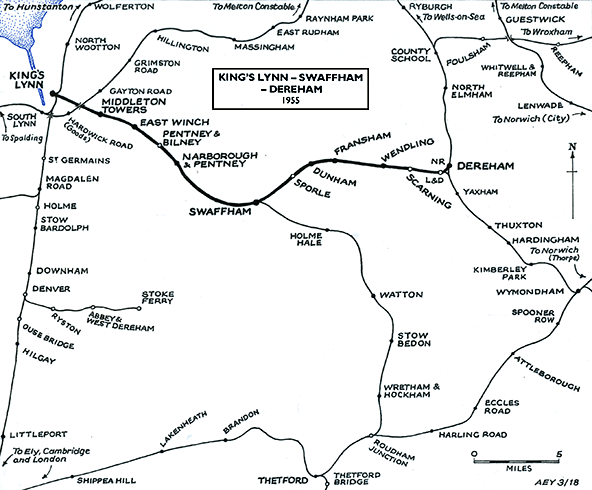
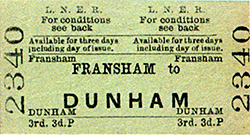 On 20 April 1886 Saxby & Farmer were contracted to provide a 15-lever signal box at the station. and on 1 March 1887 the contract for a footbridge was awarded to Messrs. Heavyside. The steel footbridge with open diamond-latticed sides that crossed both tracks at the west side of the level crossing. This was a feature, amongst the smaller stations on the line, that appears to be unique to Fransham. Why it was built is a mystery. It was taken down in 1936. As it had done at other stations, the Great Eastern Railway also provided a waiting room on the platform some time after 1884. At Fransham it was of red brick with an attractive arched tops over its door and single window: it sported a single chimney stack at the east end. Its roof was probably of red tiles and the roofline was parallel to the track. The building was located about mid-way on the platform.
On 20 April 1886 Saxby & Farmer were contracted to provide a 15-lever signal box at the station. and on 1 March 1887 the contract for a footbridge was awarded to Messrs. Heavyside. The steel footbridge with open diamond-latticed sides that crossed both tracks at the west side of the level crossing. This was a feature, amongst the smaller stations on the line, that appears to be unique to Fransham. Why it was built is a mystery. It was taken down in 1936. As it had done at other stations, the Great Eastern Railway also provided a waiting room on the platform some time after 1884. At Fransham it was of red brick with an attractive arched tops over its door and single window: it sported a single chimney stack at the east end. Its roof was probably of red tiles and the roofline was parallel to the track. The building was located about mid-way on the platform. 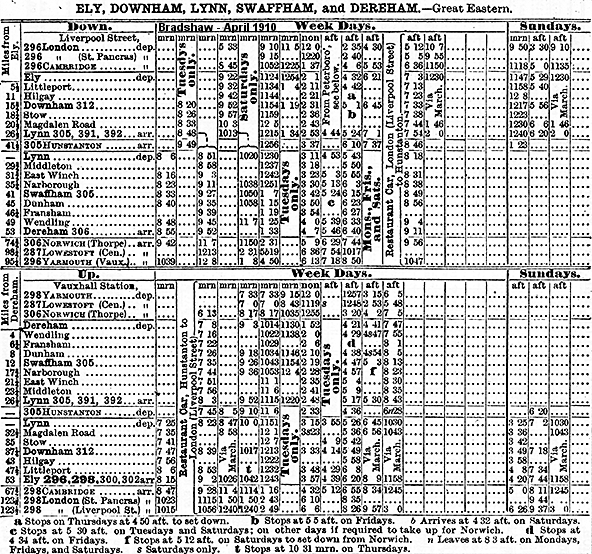
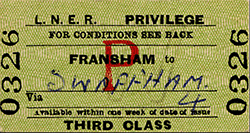 Fransham was one of five stations on the Lynn & Dereham that had become request stops soon after opening. That was the case in 1866 when the timetable showed three trains in each direction at the station on weekdays and one on Sundays. Passengers wishing to board had to arrive five minutes before the scheduled departure time: to alight the guard had to be notified earlier in the journey. As at other stations, on Saturdays only, a train catering for Norwich market-goers and not shown in the tables called at Fransham, doing so a few minutes after 9.00am. Homeward-bound passengers were advised to travel on the 5.20pm from the city and change onto a waiting train at Dereham.
Fransham was one of five stations on the Lynn & Dereham that had become request stops soon after opening. That was the case in 1866 when the timetable showed three trains in each direction at the station on weekdays and one on Sundays. Passengers wishing to board had to arrive five minutes before the scheduled departure time: to alight the guard had to be notified earlier in the journey. As at other stations, on Saturdays only, a train catering for Norwich market-goers and not shown in the tables called at Fransham, doing so a few minutes after 9.00am. Homeward-bound passengers were advised to travel on the 5.20pm from the city and change onto a waiting train at Dereham. 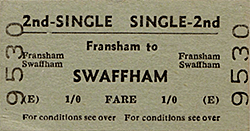 The poor goods facilities at the station reflected in the sparse service offered. The sample timetable to hand is for 1932 when the only up goods that would definitely stop at Fransham was the 12.50pm Norwich to Lynn. Running only on Saturdays it would be found at Fransham at 5.40pm. The 7.40am Dereham to Lynn goods would call on any weekday if there was traffic to be handled. Towards Dereham no goods trains made a regular stop. An 11.55am Class D from Lynn would stop if necessary at about 2.40pm: it did not run on Tuesdays and Saturdays. On Saturdays it left Lynn at 12.45pm and might call, if traffic was available, about 3.00pm.
The poor goods facilities at the station reflected in the sparse service offered. The sample timetable to hand is for 1932 when the only up goods that would definitely stop at Fransham was the 12.50pm Norwich to Lynn. Running only on Saturdays it would be found at Fransham at 5.40pm. The 7.40am Dereham to Lynn goods would call on any weekday if there was traffic to be handled. Towards Dereham no goods trains made a regular stop. An 11.55am Class D from Lynn would stop if necessary at about 2.40pm: it did not run on Tuesdays and Saturdays. On Saturdays it left Lynn at 12.45pm and might call, if traffic was available, about 3.00pm.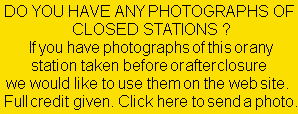
 Home Page
Home Page